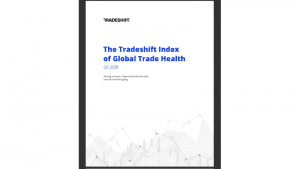
“China’s bounceback provides a useful indicator of what the shape of recovery could begin to look like as other countries start to bring the spread of the virus under control,” said Christian Lanng, CEO, Tradeshift. “A huge domestic market gives China certain advantages in terms of the speed of its recovery. But the interconnected nature of global supply chains means that not even China can fully recover in isolation. The whole ecosystem needs to be in good working order. Right now that is not the case.”

Tradeshift’s Global Index of Trade Health
Tradeshift has a ‘Global Index of Trade Health‘. This uses analysis of business-to-business transaction data to present a week-by-week picture of trade activity across global supply chains. Its credibility derives from the 1.5M+ buyers and suppliers that use Tradeshift to:
- place orders and process invoices
- transact some US$500B in annual value across the Tradeshift commerce platform.
The Index provides analysis of business-to-business transaction volumes (orders processed from buyers and invoices processed from suppliers) across the Tradeshift network during the period of 1 April 2020 through 30 June 2020. Its authors:
- looked at transaction volumes for each month during this second quarter period
- compared them to an average of the monthly transaction volumes occurring on the Tradeshift platform during the first quarter of 2020 (1 January – 31 March).
Given the impact of COVID-19 lockdown restrictions on global trade, the authors also:
- provide weekly analysis of transactions
- compare these to the average weekly transaction levels that occurred prior to lockdown.
China, which experienced the most significant impact on trade in Q1, saw trade activity rise by 31.8% in Q2. Transaction volumes in China surged by an astonishing 430% when factories reopened at the end of February. Activity then rose by a further 14% as lockdown restrictions began to ease in April. However, this momentum has begun to plateau. Average weekly transactions in China have fallen by 8% since the week commencing 15th June and, as impressive as the country’s bounceback has been, trade activity in the last two weeks of June remained 22% lower than the levels Tradeshift saw on its platform in the final quarter of 2019.
In marked contrast:
- the UK experienced the biggest drop in trade among western economies during Q2 with transaction volumes dropping by >23%
- in the Eurozone it was not much better: transaction volumes fell by 21.9%
- the US saw reduced activity, ‘only’ down 16.1%.
Green shoots? Credit constraints?
For economies in the West, the green shoots of some form of recovery are emerging. But the overall picture remains volatile.
After record lows through April and May, order volumes have begun to trend upwards over the past month:
- the Eurozone has benefited the most from a ‘post-lockdown bounce’, with order numbers rising 24% in June (compared to lows of April)
- the US’ and UK’s orders, while they have started to improve since the end of May, have seen a much less impressive surge in activity.
While order volumes are trending upwards, payments to suppliers are not keeping pace with the recovery. Invoice volumes across the EU, UK and US fell by 19% as a whole in Q2 though activity is picking up slowly as economies head into Q3. The result: many suppliers are running low on cash after a prolonged period of inactivity.
Lack of working capital flowing through supply chains could yet prevent suppliers from fulfilling orders, This risks placing a brake on recovery. Tradeshift says it is providing ‘digitised financing options’ which facilitate the early payment of invoices from suppliers. Indeed, Tradeshift has a partnership with Denmark’s Export Credit Agency designed to unlock in excess of US$55B in liquidity through a supply chain finance programme.
“Trying to restart supply chains without fast and predictable access to working capital is a little like trying to start a car without any gas in the tank. It doesn’t get you very far,” said Lanng. “Government stimulus has done a great job insulating businesses from the very worst of lockdown. But as we enter a new chapter in the pandemic, we need to start looking at fresh ways to unlock liquidity and get it flowing quickly to cash-starved suppliers.”
Enterprise Times: what does this mean
The figures which Tradeshift has produced are interesting, if not that encouraging in economic terms. Few will experience a shock to learn the UK is so badly affected.
What is more interesting to Enterprise Times is the use by Tradeshift of its trade data to identify longer terms patterns. As a long term source of such blockchain data, derived from the ability to examine what Tradeshift’s participants do in aggregate, such analyses could become useful tools for governments and macros economists alike – not something that Enterprise Times would have predicted. Enterprise Times hopes that other blockchain-based trade platforms will see fit to do likewise and publish.


























